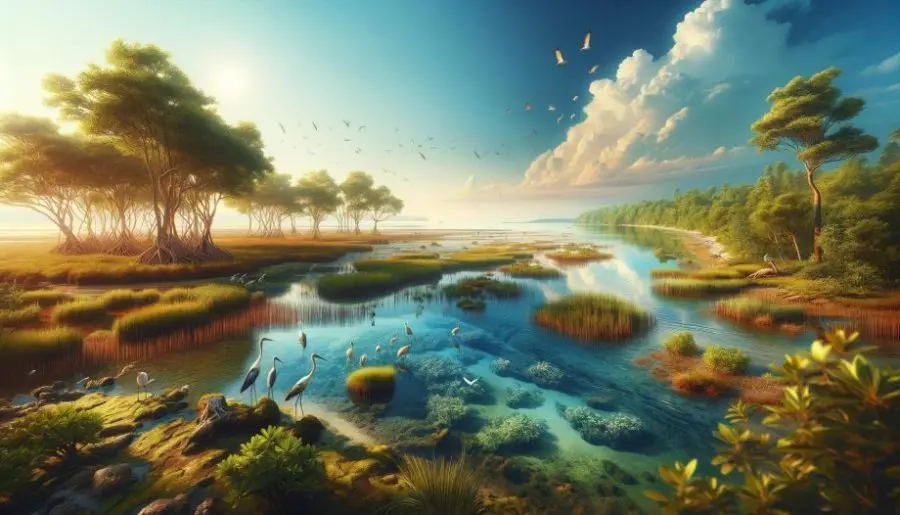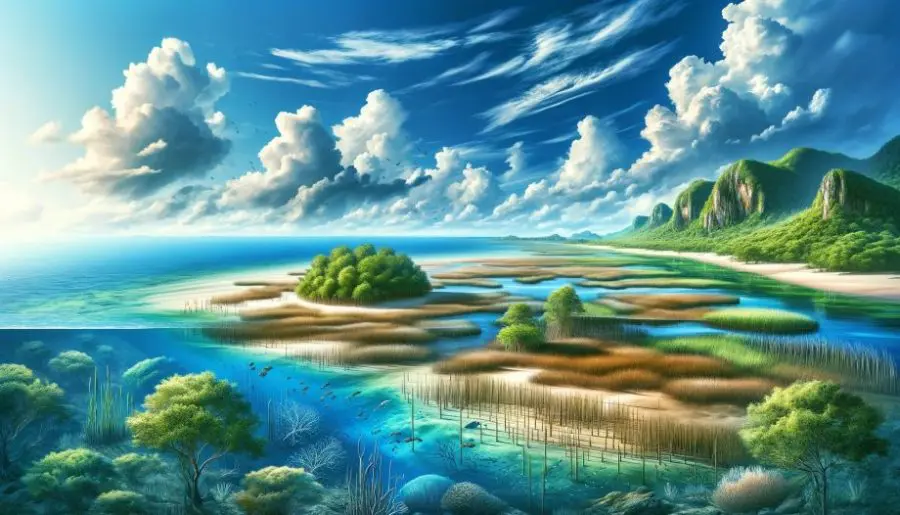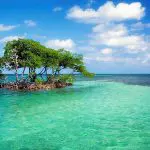II. The Impact of Climate Change on Coastal Ecosystems
Climate change is dramatically altering coastal ecosystems. Rising sea levels, more frequent and intense storms, and increasing ocean acidification are major threats.
These changes disrupt the delicate balance of these environments, impacting their ability to protect coastlines, support marine life, and maintain biodiversity.
Let’s delve into how these shifts are reshaping our coastal landscapes.
Rising Sea Levels: The Encroaching Oceans
Submerging Habitats:
- Rising sea levels, due to melting ice caps and glaciers, are submerging coastal habitats.
- This leads to the loss of vital ecosystems like mangroves and salt marshes, reducing their capacity to support diverse life forms.
Increased Salinity and Habitat Shifts:
- Higher sea levels change the salinity of coastal waters, affecting the species composition in these habitats.
- Some species may decline or move, altering the ecological balance.
Increased Storm Frequency: Nature’s Fury Intensified
Enhanced Erosion and Habitat Destruction:
- More frequent and severe storms lead to increased erosion, damaging coastal ecosystems.
- This can destroy habitats, like seagrass beds and nesting sites, essential for many species.
Disruption of Ecological Processes:
- Storm surges and flooding can disrupt the normal processes of these ecosystems.
- This includes affecting reproductive cycles and food availability for marine life.
Ocean Acidification: The Silent Disruptor
Impacts on Marine Life:
- Acidification, caused by increased CO2 absorption by oceans, affects shell-forming species and coral reefs.
- This disrupts food chains and alters habitats, impacting the broader ecosystem.
Long-Term Ecological Consequences:
- The gradual change in ocean chemistry can lead to significant shifts in species distribution and ecosystem health.
- It may result in the loss of biodiversity and the weakening of ecosystem services.
The Overall Impact
In this section, we explored the profound impacts of climate change on coastal ecosystems.
We looked at the consequences of rising sea levels, increased storm activity, and ocean acidification, shedding light on the need for urgent action to mitigate these effects and protect these vital natural resources.
- These changes not only affect the health and function of coastal ecosystems but also the communities and wildlife that depend on them.
- Understanding and addressing the impacts of climate change on these environments is critical for their survival and our own.
Table 1: The Impact of Climate Change on Coastal Ecosystems
| Climate Change Effect |
Impact on Coastal Ecosystems |
| Rising Sea Levels |
Submerged habitats alter salinity, and lead to the loss of ecosystems like mangroves and salt marshes. |
| Increased Storm Frequency |
Causes enhanced erosion and habitat destruction, and disrupts ecological processes. |
| Ocean Acidification |
Affects shell-forming species and coral reefs, disrupts food chains, and alters habitats. |
III. Coastal Ecosystems as Natural Climate Solutions
Coastal ecosystems are not just victims of climate change; they are also part of the solution.
These areas are exceptional in storing and sequestering carbon, a process crucial for mitigating climate impacts.
Additionally, they act as natural barriers, shielding coastlines from storms and erosion.
This dual role makes them invaluable in our climate strategy.
Carbon Storage and Sequestration Champions
- Mangroves, Salt Marshes, and Seagrasses:
- These ecosystems store carbon in their plant matter and soil, often more efficiently than terrestrial forests.
-
- The carbon stored, known as ‘blue carbon’, is vital in reducing greenhouse gases in the atmosphere.
- Long-term Carbon Locking:
- Coastal habitats sequester carbon for centuries, making them long-term carbon sinks.
-
- Protecting and restoring these areas enhances their capacity to absorb and store carbon.
Natural Defenses Against Climate Impacts
- Protection from Storms and Surges:
- Coastal ecosystems like mangroves and salt marshes absorb the energy of waves and storm surges.
-
- This natural barrier protects inland areas from flooding and erosion.
- Erosion Control and Shoreline Stabilization:
- The root systems of these plants stabilize the soil, preventing erosion.
-
- This helps maintain the coastline’s shape and provides a buffer zone for habitats and human settlements.
Broader Climate Regulation
- Beyond carbon storage, these ecosystems also contribute to climate regulation.
- They influence local weather patterns and help maintain regional climate stability.
A Global and Local Priority
- The conservation and restoration of coastal ecosystems are crucial in global efforts to combat climate change.
- Recognizing and investing in these natural solutions is key to a sustainable and resilient future.
In this section, we delved into the role of coastal ecosystems as natural allies in the fight against climate change.
Their ability to store carbon and act as protective barriers highlights their importance.
Emphasizing these ecosystems in climate strategies can offer significant benefits for our planet’s health and stability.
IV. Current Threats to Coastal Ecosystems
Coastal ecosystems face numerous threats, mainly due to human activities.
Pollution, overfishing, and habitat destruction are at the forefront, jeopardizing the health and survival of these critical environments.
Understanding these threats is key to devising strategies to mitigate their impact and preserve these vital natural resources.
Pollution: The Toxic Challenge
- Types and Sources of Pollution:
- Coastal areas suffer from various pollutants, including plastic waste, oil spills, and agricultural runoff.
-
- These pollutants damage the delicate ecosystems, affecting water quality and marine life.
- Impact on Biodiversity and Health:
- Pollution leads to the decline of species, disrupts food chains, and causes health issues in marine organisms.
-
- It also affects the ability of these ecosystems to function effectively and provide services like carbon sequestration.
Overfishing: The Unsustainable Harvest
- Depletion of Fish Populations:
- Intensive fishing practices have led to the decline of fish stocks in coastal waters.
-
- This imbalance affects the entire marine food web, including the predators and prey that maintain ecosystem balance.
- Impact on Habitat and Species Interactions:
- Overfishing alters habitat structures and species interactions, leading to ecological shifts.
-
- It can result in the loss of key species, further destabilizing these environments.
Habitat Destruction: The Loss of Ecosystems
- Causes and Forms of Destruction:
- Coastal habitats are destroyed for urban development, agriculture, and industrial activities.
-
- This includes the clearing of mangroves, draining of salt marshes, and damage to seagrass beds.
- Long-Term Ecological Impacts:
- Habitat destruction leads to a loss of biodiversity and ecosystem services.
-
- It reduces the resilience of these areas to climate change and other environmental stresses.
The Combined Effect
- These threats not only endanger the ecosystems themselves but also the numerous species that depend on them, including humans.
- Addressing these challenges is essential for the preservation and restoration of coastal ecosystems.
This section highlights the pressing human-induced threats to coastal ecosystems, emphasizing the urgent need for action to safeguard these crucial environments for the future.
Understanding these threats is the first step in reversing the damage and ensuring the long-term health of our coastal areas.
V. Strategies for Protecting and Restoring Coastal Ecosystems
Protecting and restoring coastal ecosystems requires a multifaceted approach.
Conservation strategies like establishing protected areas, promoting sustainable fishing, and controlling pollution are crucial.
Equally important are restoration efforts, such as replanting mangroves and restoring seagrass beds.
These actions are key to preserving these ecosystems for future generations.
Conservation Strategies
- Establishing Protected Areas:
- Creating marine reserves and protected coastal zones helps preserve critical habitats.
-
- These areas limit human activities, allowing ecosystems to thrive and recover naturally.
- Promoting Sustainable Fishing Practices:
- Implementing sustainable fishing methods ensures the long-term health of fish populations and their habitats.
-
- This includes regulating fishing quotas, using eco-friendly gear, and protecting breeding grounds.
- Effective Pollution Control:
- Enforcing strict regulations on industrial and agricultural runoff can significantly reduce coastal pollution.
-
- Initiatives like plastic waste reduction and oil spill prevention are also vital.
Restoration Efforts
- Replanting Mangroves and Other Coastal Vegetation:
- Restoring mangrove forests and other native vegetation is crucial in stabilizing shorelines and rebuilding habitats.
-
- These efforts also enhance carbon sequestration and biodiversity.
- Restoring Seagrass Beds and Coral Reefs:
- Rehabilitation of seagrass beds and coral reefs is vital for maintaining marine biodiversity.
-
- These efforts help in rebuilding the natural structure and function of these ecosystems.
Community Involvement and Education
- Engaging local communities in conservation and restoration projects is essential.
- Education and awareness programs can foster a sense of stewardship and encourage sustainable practices.
Global and Local Coordination
- Combining global initiatives with local actions ensures a comprehensive approach to ecosystem protection.
- Collaboration among governments, NGOs, and communities is key to effective conservation and restoration efforts.
In this section, we explored various strategies and efforts aimed at protecting and rejuvenating coastal ecosystems.
From conservation to restoration, these actions offer hope and a pathway for maintaining the health and resilience of these critical natural environments.
Table 2: Strategies for Protecting Coastal Ecosystems
| Conservation Strategy |
Description |
| Establishing Protected Areas |
Creating marine reserves to limit human activities and allow ecosystems to recover. |
| Promoting Sustainable Fishing |
Implementing eco-friendly fishing practices to maintain fish populations. |
| Effective Pollution Control |
Enforcing regulations to reduce coastal pollution from various sources. |
| Replanting Mangroves |
Restoring mangrove forests to stabilize shorelines and rebuild habitats. |
| Restoring Seagrass Beds |
Rehabilitating seagrass beds to maintain biodiversity and water quality. |
VI. Global and Local Initiatives
Around the world, numerous global and local initiatives demonstrate successful conservation and restoration of coastal ecosystems.
These projects showcase the power of policy and community involvement in making real environmental change.
Highlighting these efforts provides valuable insights and inspiration for future actions to protect our precious coastal environments.
Global Conservation Success Stories
- International Agreements and Programs:
- Global initiatives like the Ramsar Convention on Wetlands and the Mangrove Alliance focus on protecting vital wetlands and mangroves.
-
- These programs provide frameworks for countries to collaborate on conservation efforts.
- Large-Scale Restoration Projects:
- Massive restoration projects, such as the Coral Triangle Initiative, illustrate successful global cooperation.
-
- These initiatives involve multiple countries working together to protect and restore vast marine areas.
Local Efforts Making a Difference
- Community-Led Conservation:
- Local communities are engaging in grassroots projects, like community-managed marine reserves, which have shown significant success.
-
- These efforts often combine traditional knowledge with modern conservation techniques.
- Urban Coastal Revitalization:
- Cities near coasts are implementing projects to restore local ecosystems, such as urban mangrove parks and artificial reefs.
-
- These initiatives not only enhance biodiversity but also provide recreational spaces for communities.
The Role of Policy and Community Involvement
- Effective policies at both global and local levels are crucial for the success of conservation efforts.
- Community involvement ensures that conservation actions are sustainable and tailored to local needs and conditions.
Collaboration for Greater Impact
- Collaborative efforts between governments, NGOs, scientists, and local communities can lead to more impactful and long-lasting results.
- Sharing knowledge and resources across borders and communities fosters a united front in protecting coastal ecosystems.
This section focuses on the successes achieved through global and local initiatives in coastal ecosystem conservation and restoration.
It emphasizes the importance of policy and community involvement in these efforts, highlighting the collective action needed to safeguard these environments for future generations.
VII. The Benefits of Protecting Coastal Ecosystems
The benefits of protecting coastal ecosystems extend far beyond their boundaries.
They offer significant environmental, economic, and social advantages, contributing to a healthier planet.
Preserving these ecosystems is not just an ecological imperative; it’s essential for future climate resilience and the well-being of communities worldwide.
Environmental Benefits: A Healthier Planet
- Biodiversity Preservation:
- Coastal ecosystems are hotspots for biodiversity, supporting a wide range of species.
-
- Their protection ensures the survival of numerous plants, animals, and marine life, maintaining ecological balance.
- Climate Change Mitigation:
- These ecosystems play a crucial role in carbon sequestration, helping to combat global warming.
-
- Their preservation is key to mitigating climate change impacts.
Economic Benefits: Sustainable Livelihoods
- Fisheries and Tourism:
- Healthy coastal ecosystems support fisheries and attract tourism, both vital for local and global economies.
-
- They provide sustainable livelihoods for millions of people around the world.
- Natural Resource Provision:
- These areas supply valuable resources like fish, timber, and medicinal plants, contributing to economic stability.
-
- Sustainable management of these resources ensures long-term economic benefits.
Social Benefits: Community Wellbeing
- Cultural and Recreational Value:
- Coastal ecosystems hold significant cultural importance for many communities and offer recreational opportunities.
-
- They contribute to the cultural identity and quality of life of local populations.
- Education and Research:
- These areas serve as natural laboratories for education and scientific research, enhancing our understanding of the environment.
Future Climate Resilience: Preparing for Tomorrow
- Protecting coastal ecosystems increases our resilience against climate change, like rising sea levels and extreme weather events.
- Healthy ecosystems mean stronger, more adaptable communities in the face of environmental challenges.
This section underscores the diverse benefits of protecting coastal ecosystems.
It highlights their critical role in environmental health, economic stability, and social well-being, emphasizing their importance in building a resilient future against the backdrop of climate change.
These benefits reinforce why preserving these ecosystems is vital for the planet and humanity.
VIII. How Individuals Can Contribute
Every individual has the power to make a difference in protecting coastal ecosystems.
Through simple, everyday actions and choices, we can collectively contribute to their conservation.
From supporting environmental organizations to making responsible consumer choices, every effort counts.
Raising awareness and advocating for these ecosystems can lead to significant positive change.
Supporting Conservation Efforts
- Donate or Volunteer:
- Supporting conservation organizations through donations or volunteering can have a big impact.
-
- Participating in local clean-up drives or habitat restoration projects contributes to ecosystem health.
- Advocate for Policy Changes:
- Individuals can advocate for environmental policies and regulations that protect coastal ecosystems.
-
- Engaging with local and national government representatives can help influence policy decisions.
Responsible Consumer Choices
- Sustainable Seafood:
- Choosing sustainably sourced seafood helps reduce overfishing and protect marine habitats.
-
- Look for certifications and labels that indicate responsible fishing practices.
- Reducing Plastic Use:
- Minimizing the use of single-use plastics can significantly reduce ocean pollution.
-
- Opting for reusable or biodegradable alternatives helps protect marine life.
Promoting Awareness and Education
- Educating oneself and others about the importance of coastal ecosystems raises awareness.
- Sharing knowledge and experiences can inspire others to take action.
Community Involvement and Collaboration
- Joining or forming local groups focused on environmental protection fosters community involvement.
- Collaborative efforts can lead to more effective and widespread conservation actions.
The Power of Individual Actions
- Each person’s actions, no matter how small, contribute to the larger goal of preserving coastal ecosystems.
- Collective efforts by individuals can lead to significant environmental improvements.
In this section, we highlight the various ways individuals can contribute to protecting coastal ecosystems.
From supporting conservation organizations to making environmentally conscious choices, individual actions play a crucial role.
Encouraging awareness and advocacy further amplifies these efforts, demonstrating the power of collective action in making a positive impact.
Protecting Coastal Ecosystems FAQs
Navigating the complexities of coastal ecosystems and their protection can raise many questions.
To help clarify these topics, we’ve compiled a list of frequently asked questions.
This section aims to provide straightforward answers, enhancing understanding and encouraging informed actions toward preserving these vital ecosystems.
Q: What Are Coastal Ecosystems and Why Are They Important?
A: Coastal ecosystems, like mangroves, salt marshes, and seagrasses, are areas where the land meets the sea. They’re important because they protect coastlines, support a diverse range of species, and help fight climate change by storing carbon.
Q: How Does Climate Change Affect Coastal Ecosystems?
A: Climate change leads to rising sea levels, more intense storms, and ocean acidification. These changes can destroy habitats, alter species populations, and reduce the ecosystems’ ability to protect coastlines and store carbon.
Q: Can Individual Actions Really Make a Difference in Protecting These Ecosystems?
A: Absolutely! Individual actions, such as supporting conservation efforts, making sustainable choices, and raising awareness, collectively make a significant impact on protecting coastal ecosystems.
Q: What Are Some Examples of Successful Coastal Ecosystem Conservation Projects?
A: Successful projects include the restoration of mangrove forests in Southeast Asia and community-managed marine reserves that have revived fish populations and habitats.
Q: How Do Coastal Ecosystems Contribute to Local Economies?
A: These ecosystems support fisheries and tourism, which are vital for many local economies. They provide sustainable livelihoods and are sources of food and resources for many communities.
Q: What Can Communities Do to Help Protect Coastal Ecosystems?
A: Communities can engage in local conservation projects, advocate for sustainable policies, and participate in educational programs to understand and protect these ecosystems better.
Q: Why Is Biodiversity Important in Coastal Ecosystems?
A: Biodiversity ensures the stability and resilience of ecosystems. Diverse species interactions are crucial for maintaining healthy ecosystems, which in turn support human life and the broader environment.
Q: Are There Specific Policies That Can Help Protect Coastal Ecosystems?
A: Yes, policies like marine protected areas, regulations on pollution, and sustainable fishing practices are effective in protecting these ecosystems. International agreements, like the Ramsar Convention, also play a crucial role.
This FAQ section provides a quick reference to commonly asked questions about coastal ecosystems, their importance, and conservation efforts. It’s designed to enhance understanding and encourage active participation in preserving these critical natural resources.
Protecting Coastal Ecosystems Conclusion
Coastal ecosystems are key players in the fight against climate change.
Their role in carbon storage, biodiversity protection, and shoreline defense is invaluable.
Collective action is crucial for their preservation and restoration. By working together, we can ensure these ecosystems continue to safeguard our planet for generations to come.
Call to Action
Take part in this vital effort. Share this knowledge, engage in local conservation activities, and advocate for policies protecting coastal ecosystems.
Read more about Mangroves and Seagrass
Every action counts. Together, we can make a significant difference in preserving these precious natural resources for a healthier, more resilient world. Join the movement and be part of the solution!
Learn more: Nature-Based Solutions to Climate Change
References
- Coastal and Marine Ecosystems & Global Climate Change: Potential Effects on U.S. Resources An in-depth report on the impact of climate change on coastal ecosystems.
- The Role of Coastal Ecosystems in Climate Mitigation, United Nations Environment Programme. Provides insights into how coastal ecosystems contribute to carbon sequestration.
- Mangroves for Coastal Defence, Nature Conservancy. Discusses the role of mangroves in protecting coastlines from erosion and storms.
- Effects of Ocean and Coastal Acidification on Marine Life, National Oceanic and Atmospheric Administration (NOAA). Details the impact of acidification on marine ecosystems.
- Global Fishery Prospects Under Contrasting Management Regimes, Proceedings of the National Academy of Sciences. A study on the effects of different fishing practices on marine biodiversity.
- Marine Protected Areas and Global Conservation, International Union for Conservation of Nature (IUCN). Explores the significance of establishing marine protected areas.
- Restoration of Mangrove Ecosystems, International Society for Mangrove Ecosystems. Offers insights into successful mangrove restoration projects.
- Seagrass-Watch: Monitoring Seagrass Habitats Worldwide, A global scientific, non-destructive, seagrass assessment and monitoring program.
- Ramsar Convention on Wetlands: Key to Coastal Conservation, Ramsar Convention. Discusses international efforts and agreements for wetland conservation.
- Impact of Pollution on Coastal Ecosystems, World Wildlife Fund (WWF). Provides information on the various types of pollution affecting coastal areas and their impacts.








